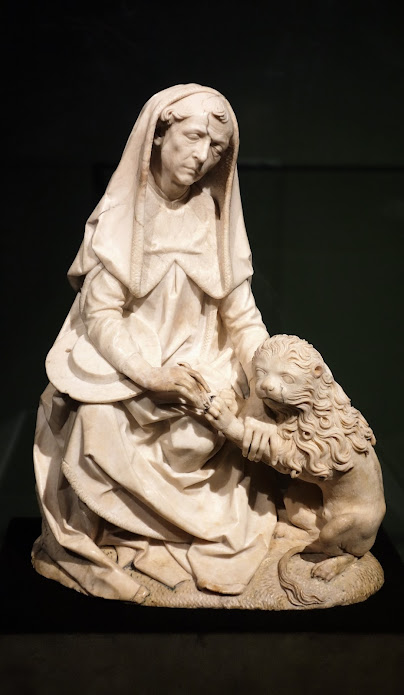When I last visited the Cleveland Museum of Art in November, just a day before it closed once again, I took lots of pictures as I went through the Medieval Galleries. I have enough for one more post. No one knows when the museum will reopen, so it may be quite a while before I can return and show you more of its outstanding collection.
One gallery is devoted to religious art from Germany and Austria during the Late Gothic Period (1300-1530). The work from this era is noted for its realism and extreme detail.
Below are two polychromed and gilded wooden carvings done by a noted German sculptor of the era, Tilman Riemenschneider. They were part of a large altarpiece created in the early 1500s for a Dominican convent in Rothenburg, Germany. The convent was demolished in 1813, but these statues survived.
St. Stephen carries stones in the folds of his cloak, symbolizing his martyrdom by being stoned to death.
St. Lawrence has a grill which symbolizes his martyrdom by being burned to death.
Another piece by Riemenschneider is this statue of St. Jerome from an abbey in Erfurt, Germany. It portrays the legend of the kindly saint removing a thorn from the paw of a lion. It is one of the few figures which the sculptor did in alabaster.
This oil painting from 1470 shows an aristocratic bridal couple. It was originally paired with another painting called "The Rotting Pair", which showed the couple as hideous corpses. The contrasting paintings formed what was known as a "Memento Mori", a reminder of the vanity of youth and the inevitability of death.
This wooden carving of the Virgin Mary holding her dead son comes from Bavaria and was sculpted in 1515. In Italian such statues are known by the name of "Pieta"... the great sculpture by Michelangelo being the most famous of all. In German, however, they are known as "Vesperbild".
This oil painting from the early 1440s by Konrad Laib portrays the "Adoration of the Magi". Laib was born in Germany but did most of his work in Salzburg, Austria.
This stained glass window from around 1520 portrays the "Kiss of Judas" and came from a Cistercian Abbey near Cologne, Germany. The abbey was closed down in 1807, and the windows were removed. Some of the other panels are now housed in London's Victoria and Albert Museum.
The final gallery of Medieval art contains three large tapestries from early 16th century France. They are known as the Chaumont Tapestries from the name of the chateau where they were found in 1851. The wall hangings were commissioned by Pierre Sala, a wealthy courtier. They were intended to instruct his daughter on secular and religious themes.
The first of the tapestries is entitled "Youth". In the center, the French Queen Mother is
addressing a group of young people. One of them is Sala's daughter Eleanore, who is playing a lute. Directly opposite her is her future husband, Hector. The verse at the top says that "youthful happiness is not eternal."
The second panel is entitled "Time". Sala stands in the center and gives his daughter a bouquet which symbolizes knowledge. Next to Eleanore is her husband Hector. The persimmon in his hand symbolizes that his young wife is pregnant. Behind Hector is his widowed mother. In a few years she and Sala will wed. To the right, the elderly figure of Time and Clio, the muse of history, are attacked by a young man.
The final panel is "The Triumph of Eternity". It shows the Virgin Mary being crowned by angels.
Hopefully the museum will reopen soon, and I will be able to show you more of its treasures.











I really, really, really want to visit this museum.
ReplyDeleteIt may not be nearly as big as some museums such as the Louvre or the Metropolitan Museum of Art, but it can take days to thoroughly see everything. And the collection is of very high quality and covers the entire span of art history.
DeleteI wrote that, btw. Not sure why it didn't prompt a login.
ReplyDeleteHope you are doing well and staying safe.
Thank you, Scott. I am hanging in there. Hope you are doing well too, and that someday we will once again be able to travel. Happy holidays!
DeleteSame to you.
Delete